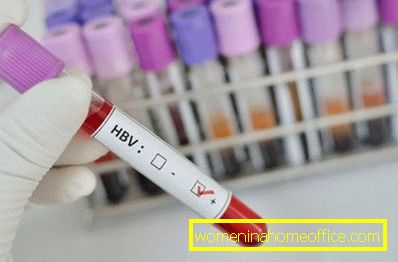How is hepatitis b transmitted
This disease is severe and quite common. Approximately 2 billion people on our planet went through infection with a dangerous virus, more than 350 million people are sick. To avoid the risk of infection, it is necessary to know how hepatitis B is transmitted, and to exercise maximum caution when a health hazard occurs.
Hepatitis B is a viral infection that affects the liver. The main mode of transmission is blood, therefore, the disease is also called serum hepatitis. The danger of infection is manifested in the severity of the consequences: these are cirrhosis of the liver, acute liver failure and the development of cancer of the organ. A distinctive feature of the hepatitis B virus is its resistance to external influences and the property for a long time to remain in the environment.
How is hepatitis B transmitted?

Most often, hepatitis B develops due to a virus in a healthy person’s blood that is found in the blood or biological fluids of an infected person. Much less often the cause of infection are sex. Sometimes the virus gets to the baby from the mother during birth, when it passes through the birth canal.
As already noted, the greatest danger of the hepatitis B virus lies in its persistence. Outside the human body, he can live for at least 7 days. After entering the unprotected body of the virus, the virus manifests itself on average after 75 days (figures range from 1 to 6 months). In the future, the disease can occur both in acute and in chronic form.
The causative agent of hepatitis B usually develops in the blood, semen, vaginal discharge. Much less of it is in the patient's sweat, saliva, tears, urine and feces.
Medical science investigated all ways of how hepatitis B is transmitted to others. This happens in such situations:
- with blood transfusion. According to world statistics, among possible donors, the number of people infected with the hepatitis virus is from 0.01 to 2%. A mandatory requirement before transfusion is to check the blood or its preparations for the content of the hepatitis B virus;
- due to multiple use of a single syringe. Hepatitis B is widespread among people who inject drugs;
- during sexual intercourse. This type of infection is most characteristic of hepatitis B, which distinguishes it from other types of the disease. For example, medical research into whether sexually transmitted hepatitis C has been shown to be extremely rare;
- at birth, the child is transmitted from the mother. Doctors call this way "vertical". Infection with this method is quite rare. The risk of infection is high if the expectant mother has an active form of the virus or a woman has had acute hepatitis in late pregnancy. The threat to inherit the disease increases if the woman is infected with two dangerous viruses - hepatitis and immunodeficiency;
- due to insufficient sterilization of instruments for dental or cosmetic procedures. There is also a significant risk of contracting acupuncture, skin piercing for piercing, tattooing.
It is very important to remember the potential danger yourself and explain all the nuances to children, especially adolescents. For example, it would not be superfluous to talk about the fairly widespread opinion that hepatitis B and C is transmitted through a kiss. Such a path is considered very unlikely. A virus can be transmitted from an infected person to a healthy one only if both kissing have open wounds on their lips.
In addition, the hepatitis B virus is not transmitted when using common dishes, towels. But to use someone's razor or toothbrush is impossible. The virus contains little in sweat and saliva, but the danger lies in the fact that infected blood could get onto such hygiene items.
Who risks the most?

In principle, practically no one is immune from infection with the hepatitis B virus. After all, sooner or later everyone has to visit dental offices, most modern people can not do without a professional manicure and pedicure. According to medical statistics, this disease affects about 2% of the world's population. Generally, people aged 20 to 49 suffer from hepatitis.
The main method of dealing with an insidious virus is regular vaccination. In this way, it is possible to reduce the number of infected among young people. Vaccinations for hepatitis, which are given to children under the age of 1 year, contribute to the development of their strong immunity until reaching 18-19 years.
Everybody is obliged to carefully monitor their health. But there are categories of people who are most at risk of getting hepatitis B. These include:
- suffering from bleeding disorders (hemophilia) and other patients in need of blood transfusion;
- hemodialysis patients (blood purification through an artificial membrane using an artificial kidney machine);
- injecting drug users;
- who had intimate relationships with at least 2 partners in the current six months;
- recently recovered from a venereal disease;
- sexual partners and family members of the carrier of the virus of this species;
- family members of persons who are at risk;
- health care workers;
- in places of deprivation of liberty (talking about long stay);
- traveling to areas with a high prevalence of infection and staying there for longer than 6 months.
Hepatitis B is one of the most serious diseases of our time. This viral infection is mainly transmitted through blood, less commonly through other body fluids. In order not to give the virus a chance, you need to be very careful in situations in which the risk of infection increases. Vaccination helps protect against hepatitis B. It is important to contact the doctors as soon as possible if there is a suspicion of possible infection.